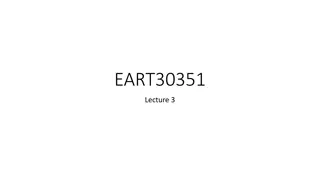
Physical Chemistry 2: Gibbs Energies and Phase Diagrams Overview
Explore the Clapeyron and Clausius-Clapeyron equations, Gibbs energies, phase boundaries, and more in Physical Chemistry 2 by Dr. M. Masykuri. Learn about the chemical potential, equilibrium, and the Clapeyron Equation for predicting phase diagrams and transitions.
Download Presentation

Please find below an Image/Link to download the presentation.
The content on the website is provided AS IS for your information and personal use only. It may not be sold, licensed, or shared on other websites without obtaining consent from the author. If you encounter any issues during the download, it is possible that the publisher has removed the file from their server.
You are allowed to download the files provided on this website for personal or commercial use, subject to the condition that they are used lawfully. All files are the property of their respective owners.
The content on the website is provided AS IS for your information and personal use only. It may not be sold, licensed, or shared on other websites without obtaining consent from the author.
E N D
Presentation Transcript
Physical Chemistry 2 Persamaan Clapeyron dan Persamaan Clausius- Clapeyron Dr. M. Masykuri, M.Si. Dr. M. Masykuri, M.Si. Chemistry Education Study Program Teacher Training and Education Faculty Sebelas Maret Universitfy (UNS) Website: http://mmasykuri.wordpress.com, email: mmasykuri@yahoo.com Teacher Training and Education Faculty Sebelas Maret University 3/20/2025 1 M. Masykuri_Physical Chemistry 2 Solo, Peb 2020 Feb 2020
Outline 1. Persamaan Clapeyron 2. Persamaan Clausius-Clapeyron 3. Aturan Trouton 4. Mengkonstruksi Diagram Fasa Teacher Training and Education Faculty Sebelas Maret University M. Masykuri_Physical Chemistry 2 Feb 2020
Gibbs Energies and Phase Diagrams Chemical potential ( ) - for one component system =Gm Measure of the potential of a substance to bring about change At equilibrium, is the same throughout the system If 1 is chem. potential of phase 1 and 2 is chem. potential of phase 2, at equilibrium 1 = 2 Consequence of 2nd Law of Thermodynamics If dn is transferred from one location (phase) to another, - 1dn, is the change in Gibbs energy in that phase and 2dn is change in free energy in the second phase. Teacher Training and Education Faculty Sebelas Maret University M. Masykuri_Physical Chemistry 2 Feb 2020
Gibbs Energies and Phase Diagrams dG = - 1dn + 2dn = ( 2 - 1)dn If 1 > 2 dG < 0 and change spontaneous If 1 = 2 dG = 0 and system at equilibrium Transition temperature is that temperature where 1 = 2 Chemical potentials of phases change with temperature At low T and reasonable p, solid has lowest and, hence, most stable As T raised, of other phase may become less than solid(at that temp.) so it becomes stable phase Teacher Training and Education Faculty Sebelas Maret University M. Masykuri_Physical Chemistry 2 Feb 2020
Location of Phase Boundaries Phase boundaries occur when chemical potentials are equal and phases are in equilibrium, or for phases and : (p,T) = (p,T) Need to solve this equation for p, p= f(T) On plot of p vs. T, f(T) is a gives the phase boundary Slopes of phase boundaries Slope is dp/dT If p and T are changed such that two phases, and , are in equilibrium, d = d But, d = -SmdT + Vdp So, -S m,dT + V mdp = -S m,dT + V mdp Or(S m,-S m,)dT + = (V m- V m )dp But (S m,- S m,) = trsS and (V m - V m) = trsV Teacher Training and Education Faculty Sebelas Maret University M. Masykuri_Physical Chemistry 2 Feb 2020
Location of Phase Boundaries This rearranges to: dp/dT = trsS / trsV where and are the entropy and volume of transition This is called the Clapeyron Equation Exact expression for the phase boundary at equilibrium Can be used to predict appearance of phase diagrams and form of boundaries Teacher Training and Education Faculty Sebelas Maret University M. Masykuri_Physical Chemistry 2 Feb 2020
Solid-Liquid Boundary For solid-liquid boundary, Clapeyron Equation becomes dp/dT = fusS / fusV where fusV is the change in molar volume on melting fusS is always positive (except for 3He) and fusV is usually smallso dp/dT is large (steep slope) and positive Formula for phase boundary comes from integrating Clapeyron equation Teacher Training and Education Faculty Sebelas Maret University M. Masykuri_Physical Chemistry 2 Feb 2020
Solid-Liquid Boundary dp = fusS fusVdT trsS = trsH recall ,so T dp = fusH T fusVdT Integrating fusV p p* = fusH = fusH 1 T p T T* dp p* dT, where T* is melting temperature @p* T T* fusVln ln 1+T T* T T* If T close to T*,ln T p p* = fusH fusVln 1+T T* T Teacher Training and Education Faculty Sebelas Maret University M. Masykuri_Physical Chemistry 2 Feb 2020
Solid-Liquid Boundary This is straight line of slope [ fusH / (T* fusV)] Math Moment: ln(1+x) = x - 1/2x2+ . If x<<1, ln(1 + x) = x p p* = fusH fusVln 1+T T* p p* = fusH fusV p = p *+ fusH fusV fusH T* fusV T* or T T* T* T T* T* T T* ( ) p = p *+ Teacher Training and Education Faculty Sebelas Maret University M. Masykuri_Physical Chemistry 2 Feb 2020
Liquid-Vapor Boundary vapH T vapV dp dT= Again, Clapeyron equation can be used vapV is large and positive so dp/dT is positive, but smaller than for solid-liquid transition vapH/T is Trouton s constant Because Vm(gas) >> Vm(liquid), vapV Vm(gas) For ideal gas, Vm(gas) = RT/p so vapV RT/p Clapeyron equation becomes dp dT= vapH T vapV= vapH TRT =p vapH RT2 p dT= vapH 1 p dp RT2 dx x = d ln x ( ) ( ) Recall = vapH RT2 d(ln p) dT Clausius Clapeyron Equation Teacher Training and Education Faculty Sebelas Maret University M. Masykuri_Physical Chemistry 2 Feb 2020
Liquid-Vapor Boundary Integrating Clausius-Clapeyron equation gives variation of vapor pressure with temperature vapH R 1 T 1 p=p*e , = T* Assumes vapH is independent of T and p* is vapor pressure at T* and p the vapor pressure at T This is a curve, not a line Does not extend beyond Tc Teacher Training and Education Faculty Sebelas Maret University M. Masykuri_Physical Chemistry 2 Feb 2020
Solid-Vapor Boundary Solid-vapor boundary same as liquid vapor boundary except use subH instead of vapH Since subH > vapH, slope of curve is steeper Curves coincide at triple point along with solid-liquid boundary Teacher Training and Education Faculty Sebelas Maret University M. Masykuri_Physical Chemistry 2 Feb 2020
Solid-Vapor Boundary Solid-vapor boundary same as liquid vapor boundary except use subH instead of vapH Since subH > vapH, slope of curve is steeper Curves coincide at triple point along with solid-liquid boundary Teacher Training and Education Faculty Sebelas Maret University M. Masykuri_Physical Chemistry 2 Feb 2020
LATIHAN The normal freezing point for benzene (C6H6, M = 78.12 g/mol) is T fus = 5.50 C. The density of liquid and solid benzene at the normal freezing point are (s) = 0.891 g/cm3, ( ) = 0.879 g/cm3, and the enthalpy of fusion for benzene is H fus = 10.59 kJ/mol. a) Based on the above data, estimate the freezing point of benzene when p = 1000. atm (be careful about using consistent units). b) The vapor pressure of liquid benzene above the triple point temperature (in units of torr) is given by the expression log10p = 7.960 1780. K T Using equn 4.1, find the pressure of benzene at the triple point, and the normal boiling point for benzene. Teacher Training and Education Faculty Sebelas Maret University M. Masykuri_Physical Chemistry 2 Feb 2020
Teacher Training and Education Faculty Sebelas Maret University M. Masykuri_Physical Chemistry 2 Feb 2020


